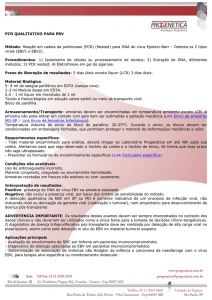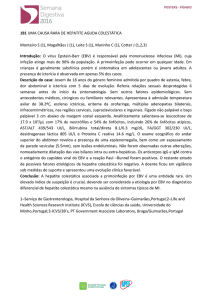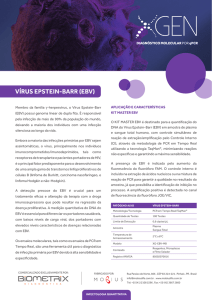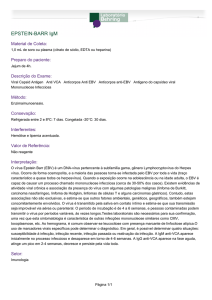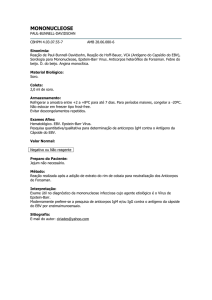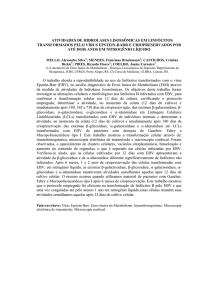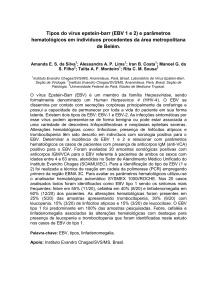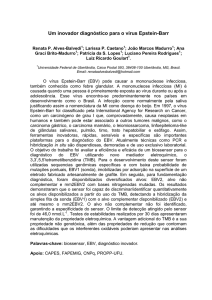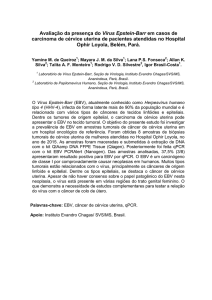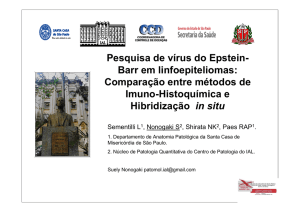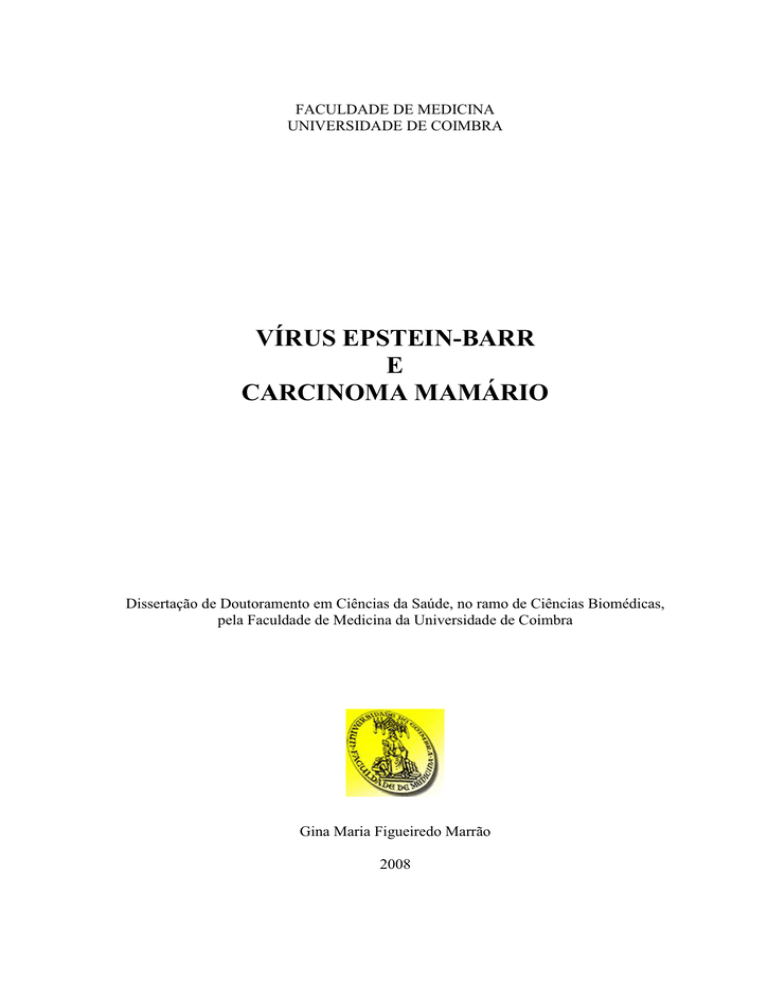
FACULDADE DE MEDICINA
UNIVERSIDADE DE COIMBRA
VÍRUS EPSTEIN-BARR
E
CARCINOMA MAMÁRIO
Dissertação de Doutoramento em Ciências da Saúde, no ramo de Ciências Biomédicas,
pela Faculdade de Medicina da Universidade de Coimbra
Gina Maria Figueiredo Marrão
2008
RESUMO
O Vírus Epstein-Barr (EBV) é um herpesvirus humano ubiquitário agente da
mononucleose infecciosa. É um vírus que tem sido associado ao desenvolvimento de
diferentes patologias malignas de natureza epitelial e linfóide, e recentemente associado
ao carcinoma da mama, representando um dos tumores mais frequentes nos países
ocidentais. Trata-se, além disso de uma doença com alto poder de metastização, com
um número significativo de doentes que morre antes dos cinco anos de evolução, após o
tratamento primário.
, com uma história
natural e um prognóstico muito variáveis.
Actualmente 21 estudos (sobre 29 publicados) demonstraram a existência de
sequências de EBV a nível dos tumores da mama na mulher. Nenhum destes estudos
traz conclusões claras sobre o papel de EBV na patogénese do tumor, principalmente
devido à falta de seguimento das doentes ao longo do tempo.
Por conseguinte, realizámos um estudo prospectivo com doentes dos Hospitais da
Universidade de Coimbra em estreita relação com o Centro de Histocompatibilidade do
Centro e a Universidade Grenoble para tentarmos responder à pergunta do papel do
EBV neste tipo de tumores.
Assim, estabelecemos como objectivo principal detectar genoma de EBV quer a
nível do tumor quer a nível dos mononucleares do sangue periférico e de associar a esta
primeira etapa experimental uma abordagem da resposta imunológica das doentes,
essencialmente baseada nas características fenotípicas e funcionais: (i) das células
dendríticas e monócitos do sangue periférico, (ii) dos linfócitos T periféricos (incluindo
as células dupla positivas CD4+/CD8+), (iii) e das células NK do sangue periférico.
Propusemo-nos comparar o seguimento das doentes em função do seu “estatuto” EBV,
mas também os factores clínicos, biológicos e anatomopatológicos utilizados na rotina
no Serviço de Ginecologia dos Hospitais da Universidade de Coimbra: invasão
ganglionar, receptores de estrogénio/progesterona, c-erB-2, histologia tumoral e
tamanho do tumor.
Como um todo, os resultados apresentados neste estudo demonstram que: (i)
existe uma associação (não significativa) entre a sobrevivência das doentes com cancro
da mama e a presença do EBV a nível dos mononucleares do sangue periférico e a nível
tumoral; (ii) As células T dupla positivas CD4+/CD8+ encontram-se aumentadas no
sangue periférico das doentes com cancro da mama com melhor sobrevivência global,
particularmente as que apresentam um fenótipo de memória efectora, reforçando a ideia
de uma potencial actividade antitumoral exercida por estas; (iii) As células T CD4 + e T
CD8+ com um fenótipo de memória central encontram-se aumentadas nos vários grupos
de doentes estudados, bem como nas doentes EBV positivo (p<0,05) (com diminuição
do fenótipo naïve) o que traduz assim uma estimulação antigénio específica; (iv) O
estudo funcional das células T e NK, mostrou que as doentes, incluindo o grupo de
doentes com tumor EBV positivo, que produzem maior quantidade de TNF-α por célula
apresentam uma melhor sobrevivência global, o que parece indicar uma melhor
actividade funcional destas células, traduzida pela produção de citocinas próinflamatórias, podendo ser um factor de melhor prognóstico; (v) As doentes com uma
percentagem mais elevada de células NK CD56 +/CD57- a expressar granzima B
apresentam uma melhor sobrevivência global, uma vez que esta proteína é um dos
mecanismos utilizados por esta célula para induzir a apoptose nas células alvo.
Em conclusão, destacamos uma série de novos biomarcadores virais (status do
EBV) e imunológicos (características fenotípicas e funcionais) para o acompanhamento
das doentes com cancro da mama e por conseguinte susceptíveis de poderem fazer parte
dos testes “teragnósticos”.
ABSTRACT
______________________________________ Abstract
Epstein-Barr virus (EBV) is a ubiquitous human herpesvirus and is the etiologic
agent of infectious mononucleosis disease. The EBV is associated with the development
of a variety of epithelial and lymphoid malignant pathologies, and recently is closely
associated with the breast carcinoma, one of the most frequent tumors in the occidental
countries. Moreover, the breast cancer is a disease with a high metastatic propensity and
with a significant number of patients dying before the five years of its evolution, after
the primary treatment. The development of the disease is not very predictable and its
natural history and prognosis are frequently changing.
Currently, 21 studies (out of 29 published) have showed the existence of EBV
sequences on woman breast tumors. None of these studies bring new conclusions on the
role of EBV in the pathogenesis of the tumor, mainly because of the lack of patient
follow-up during a period of time.
Therefore, we made a prospective study in the Hospitals of the University of
Coimbra at closely relationship with the Histocompatibility Centre of Coimbra and the
University of Grenoble for try to elucidate the role of EBV in this type of tumor.
We establish that the main goal was to detect the EBV both in the tumor and in
peripheral blood and if that event is accompanied or is closely correlated with immune
response of the patients, mainly based on the immunophenotypic and functional
characterization of: (i) the dendritic cells and monocytes, (ii) T lymphocytes
subpopulations (including the double positive CD4+/CD8+ cells), (iii) and NK cells. We
also compare the follow-up of the patients according to their EBV “status”, and of the
clinical, biological and anatomopathological factors used in a groove based on clinic
gynecology: lymph nodes invasion, estrogens/progesterone receptors, c-erB-2, tumor
histology and tumor size.
In general, the results obtained in this study showed that: (i) there is a close
correlation between the survival of patients with breast cancer and the presence of the
EBV in the peripheral blood and in the tumor; (ii) An increase in the percentage of
CD4+/CD8+ T in the peripheral blood of the patients with breast cancer with a better
overall survival, particularly those with a memory effector phenotype, seems to indicate
that these cells have a potential antitumoral activity. (iii) The peripheral T CD4+ and T
CD8+ cells with a central memory phenotype are increased in all patients groups and in
the patients with tumor EBV+ “status” (p<0,05) (with decreasing of the naïve
phenotype) supporting a role of specific antigen stimulation; (iv) The functional study
on T and NK cells showed that the patients, including the group of patients with tumor
______________________________________ Abstract
EBV+ that produce higher amounts of TNF-α, at single cell level, in both cell
populations, show a better overall survival, which seems to indicate that a better
functional activity of these cells, shows the production of pro-inflammatory cytokines
which could be a good prognostic factor; (v) The patients with a increased percentage of
NK cells CD56+/CD57- expressing granzyme B show a better overall survival, being the
protein, one of the mechanisms utilized by these cells to induct an apoptotic death in
target cells.
In conclusion, we have developed a series of new virological biomarkers (status
EBV) and immunological (at phenotype and functional levels) for the follow-up of the
breast cancer patients and include them in “theragnostic” tests.


